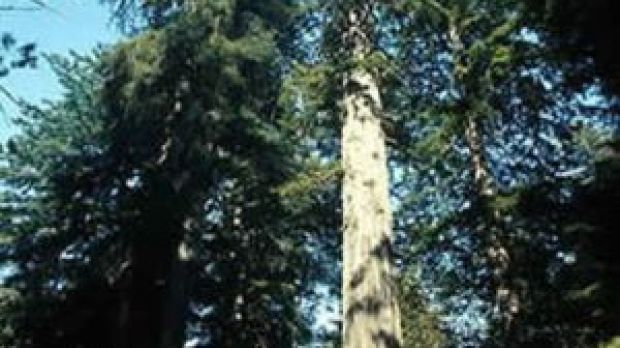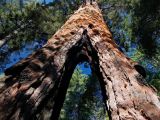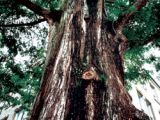1. Gymnosperms dominated the Earth's flora during the Dinosaur Era until the emergence of the flower plants (Angiosperms) during the last period of the dinos' domination. They appeared 300 million years ago and reached the climax of their development 120 million years ago. Still, one group of gymnosperms is still flourishing: the coniferous. In their niche of cold forests, they dominate. The genus Pinus (pines) has about 100 species, while the tropical Podocarpus, 75, and Juniperus (junipers), 65 species.
Surprisingly or not, the most impressive living coniferous consists in mono-species genera: Sequoia (coast redwood), Sequoiadendron (giant sequoia) and Metasequoia (dawn redwood). These trees are considered living fossils and the first two survive only in the coasts of California and Sierra Nevada mountains.
Their scientific names remember us of the Cherokee chief Sequoyah (George Guess), son of a white man and Native woman. In 1821, Sequoyah created an alphabet for the Cherokee language.
2. The coast redwood takes its name from the brown-reddish color of the wood. Sequoia sempervirens is the tallest tree in the world. An individual measured in 2006 in Redwood National Park (Northern California) was 379.1 feet (126.4 m) tall, representing the world's record. The tree grows on the western coast of US (California to southern Oregon), where the Pacific currents ensure a high humidity. The species is found up to 900 m (3,000 ft), forming an irregular band with a length of 725 km (450 mi) and a width of 8-56 km (5-35 mi). The small needle-like leaves, green-bluish, are never shed. The bark is 25 cm (10 in) thick and deeply furrowed. The cones are no more than 2.5 cm (1 in) (!) in size and mature annually.
3. The giant sequoia or mammoth tree is not as tall as the redwood, nor as wide as an baobab, still Sequoiadendron giganteum represents the largest (most massive) plant on the planet. It frequently reaches 83 m (276 ft) in height and 12 m (40 ft) in diameter, weighing 6,000 tonnes! 40 people are required to embrace such a tree... One mammoth tree is crossed by a tunnel!
Some individuals are 3,500 years old, yet they are not the oldest trees on Earth - 'title' that belong to two pine species from the mountains of southwestern USA: Great Basin Bristlecone Pine (Pinus longaeva) (photo) and Rocky Mountains Bristlecone Pine (Pinus arista): an individual of Pinus longaeva was found to have 4,900 years!.
The needle-like leaves are obliquely downward oriented and green-bluish in color. The cones are 9 cm (3.6 in) long and mature once in two years. The name of mammoth tree comes from the huge branches resembling mammoth tusks. This tree grows on the western slopes of Sierra Nevada mountains of central California, between 1,500 to 2,650 m (5,000-8,500 ft) altitude, on an area 450 km (280 mi) long and 32 km (20 mi) wide. The tree is protected inside the Sequoia National Park, founded in 1890, and the Giant Forest, where each tree has a name.
The mammoth tree is extremely resistant; some individuals bear marks of fires hundreds of years old. No individual dead of natural causes is known; only put down by cataclysms or man (the wood is extremely appreciated). The secret is found in the 50-60 cm (20-24 in) thick reddish bark which stands fires and other phenomena, because it regenerates too quickly, before the microbes manage to grow. Moreover, the wood is impregnated with aromatic bactericide chemicals.
4. Before the Ice Age, the mammoth tree lived also in Europe! The freezing exterminated them in the old continent.
5. Metasequoia is the closest living relatives of the redwood and mammoth trees. The species was first found as fossil in 1941; later, the tree was found still living in a remote area of south-central China. It resembles its American cousins, only that it is smaller and sheds its leaves annually.

 14 DAY TRIAL //
14 DAY TRIAL // 

